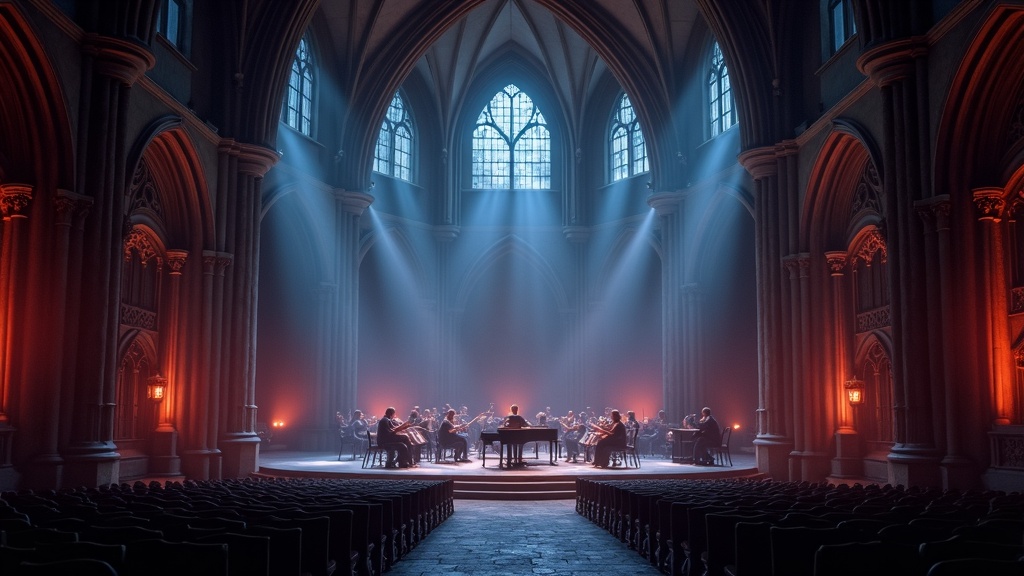If you’ve ever found yourself drawn in by the grand, cinematic sound of symphonic metal, you’re not alone. This genre brings together heavy guitars, orchestral arrangements, and some really unique vocal performances. Understanding the variety of vocal styles in symphonic metal can help you appreciate the genre even more, whether you’re just stumbling upon it or you’ve been a fan for ages. I’ll walk you through the main vocal approaches you’ll hear, how they work within the music, and why each one is worth listening for.

What Makes Symphonic Metal Vocals Unique?
Symphonic metal offers more than just heavy riffs and epic orchestration. The vocals are a huge part of what gives this genre its signature sound. You’ll hear everything from classically trained singers to intense growls, all layered over sweeping strings and thunderous drums. Unlike most other metal genres, symphonic metal is all about variety, mixing in different vocal textures and techniques to match the drama of the music.
Much of the genre’s sound is influenced by opera, classical music, and traditional metal styles. Combining these lets singers explore powerful emotions and sometimes even tell whole stories within a single song. Bands like Nightwish, Epica, and Within Temptation have made a name for themselves by spotlighting incredible voices at the forefront of their sound. These acts often switch things up by letting vocalists transition between bold, powerful sections and soft, emotionally charged passages, adding even more depth to their songs.
Key Vocal Styles in Symphonic Metal
Several main vocal styles regularly show up in symphonic metal. Here’s an overview of what you’ll typically hear and how each adds its own feeling or intensity:
- Operatic Soprano: Characterized by a bright, resonant tone and wide vocal range, often bringing a dramatic, ethereal feel.
- Rock/Pop Clean Vocals: More straightforward and accessible, often used for catchy choruses or emotional verses.
- Growling/Harsh Vocals: Adds aggression, power, or a darker tone, usually delivered by a male vocalist but sometimes by women too.
- Choral or Ensemble Vocals: Multiple singers or layered vocals mimic an actual choir or add richness to the sound.
- Baritone and Tenor Vocals: Lower male vocals can offer warmth, depth, or subtle drama when blended with higher voices.
These styles don’t always stay in their own lane. In lots of symphonic metal songs, you’ll hear them mix and switch between approaches. This keeps the music interesting and gives songs a narrative feel. Sometimes, two or three vocal styles even overlap in a single chorus, taking the drama and emotion up a notch.
Jumping Deeper: Popular Symphonic Metal Vocal Techniques
Singers in symphonic metal bands use a bunch of vocal techniques to achieve their signature sounds. Here’s a closer look at some of the most common methods you’ll notice:
- Belting: Pushing the voice loud and clear in the higher part of the range. It has a super powerful sound and often supports climactic moments in songs.
- Head Voice: Produces those soaring, almost floating tones—common in operatic metal. It’s a hallmark of bands with classically trained female vocalists.
- Vocal Fry and Growls: Used to create a gritty, aggressive edge, like what you get with Epica or some Nightwish tracks with male vocals.
- Breathy and Whispered Vocals: Sometimes singers pull back for an intimate or haunting effect, using a softer tone that still cuts through the orchestration.
- Choral Arrangements: Multiple voices are recorded or performed together to build a sense of grandeur, like the opening of many Epica songs.
The blending of these techniques can give a lot of emotional range to a single album, or even a single track. This flexibility is what keeps the genre feeling fresh. Some vocalists in this scene also add in unique touches—like brief spoken-word segments or matching their voices to an instrument’s melody—which keeps listeners guessing and engaged.
Challenges and Rewards of Symphonic Metal Singing
Singing in symphonic metal isn’t always easy. It takes training, stamina, and an ear for dynamics to keep up with the sometimes complex instrumentals. Here are some main hurdles that vocalists in this genre tend to face, plus how they deal with them:
- Vocal Stamina: Epic songs call for powerful singing, often for long periods of time, so singers need to keep their voices healthy with good technique and plenty of rest.
- Blending With Orchestration: A lot is happening instrumentally, so vocalists have to cut through the mix without straining or losing clarity. Microphone technique and dynamic control really matter here.
- Switching Styles: Jumping from a clean chorus to a growl or from a whisper to a belt in the same song demands vocal flexibility and practice. Many singers benefit from studying multiple styles, sometimes even working with coaches outside the metal scene.
- Sustaining Emotion: Symphonic metal can be super dramatic—singers are often telling a story or painting a mood, so they need both technical skill and emotional expressiveness.
It’s common for symphonic metal vocalists to train classically, study contemporary styles, or both. Singers like Floor Jansen (Nightwish) and Simone Simons (Epica) are known for their ability to switch up from operatic passages to more grounded, rockstyle singing, sometimes within a single phrase. Some even pick up growling techniques to add more grit to their performances, which makes the overall show even more dynamic.
Tips For Appreciating Symphonic Metal Vocals
Getting more out of the symphonic metal listening experience is pretty easy once you know what to listen for. Here’s how I like to make the most of these incredible vocal performances:
- Focus on Dynamics: Notice when singers pull back or build up intensity. The contrast between soft verses and huge, belted choruses can be really breathtaking.
- Listen for Harmonies: These bands love to add stacked vocals and choral effects, especially in key moments. Headphones help to spot the extra details.
- Check Out Live Performances: Watching your favorite band perform live gives a good idea of just how much vocal skill and stage presence goes into their music.
- Compare Studio and Live Versions: You’ll get a sense of how much is layered in the studio and what vocalists can pull off on stage in real time.
- Explore Different Singers: Every vocalist brings their own twist—listen to a few bands to experience a range of styles.
No two vocalists sound the same in this genre, so exploring a variety of bands can open up new favorites and show off just how wide symphonic metal’s vocal landscape really is. In addition, following lyric sheets while listening can step up your appreciation, as you start to notice the storytelling that goes hand in hand with those lush vocals.
Notable Symphonic Metal Vocalists and Their Approaches
I want to highlight a few singers who each bring something pretty special to symphonic metal. If you’re new to the genre or looking for a primer, these voices are worth your attention:
- Floor Jansen (Nightwish): Famous for blending a powerful operatic technique with grounded, emotional delivery. She’s versatile, covering both softer ballads and huge anthems with ease.
- Simone Simons (Epica): Has a warm, lyrical soprano with both classical and contemporary skills. She’s great at gliding between delicate lines and powerhouse moments.
- Tarja Turunen (ex-Nightwish): One of the most operatic voices in the genre, Tarja helped shape symphonic metal’s sound with her dramatic, highflying soprano parts.
- Sharon den Adel (Within Temptation): Known for a lighter, more popinfluenced sound but mixes in lush harmonies and expressive leads to really sell the drama.
- Mark Jansen (Epica): Also worth checking out for his deep growls, adding contrast and weight to Simone’s melodic lines.
This isn’t a complete list by any stretch, but it’s a great place to start if you want to get a sense of how varied and expressive vocal work can be in symphonic metal. There are plenty more singers out there making a mark, each putting their own stamp on things. Exploring these voices can turn you from a casual listener into a real symphonic metal enthusiast.
Common Symphonic Metal Vocal Questions
People often have questions about the vocal side of symphonic metal. Here are a few I hear often, along with what I’ve found through lots of listening and learning:
Question: Do you have to be classically trained to sing symphonic metal?
Answer: Many singers come from a classical background, especially those using operatic techniques, but you don’t have to be classically trained. Rock voices and other stylings fit right in too. Training just gives you more tools to use and helps keep your voice in good shape for those demanding songs.
Question: Why do some bands use both clean and harsh vocals?
Answer: Mixing vocal styles adds depth and emotion. Growled or harsh vocals can underline darker moods or provide contrast, while clean singing soars over symphonic elements for a dramatic effect. This back-and-forth gives the songs a much richer soundscape.
Question: Are live performances as dramatic as the studio versions?
Answer: Watching these bands live can be even more intense, especially when you see the vocalists switch up between styles seamlessly. Many recreate complex studio parts impressively well on stage, and the energy in the room can make the drama even more real. Some fans say hearing the vocals reverberate in person is a next-level cool experience.
Why Symphonic Metal Vocals Are Worth Exploring
The vocal styles in symphonic metal are a huge reason people get hooked on the genre. Whether you’re into soaring operatic lines, gritty growls, or huge choral moments, there’s something here for you. It’s a great space for vocalists to show off range, technique, and emotional storytelling, all backed by dramatic music and big ideas. If you’ve been curious about the genre, getting into its vocal side is a pretty fun way to start. Jump into a few tracks, try out live performances, and you might find yourself converted before you know it. The world of symphonic metal vocals is wide, expressive, and definitely worth checking out.
